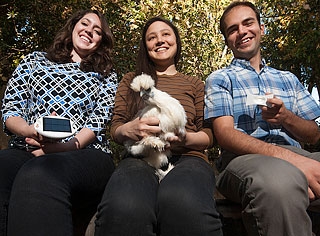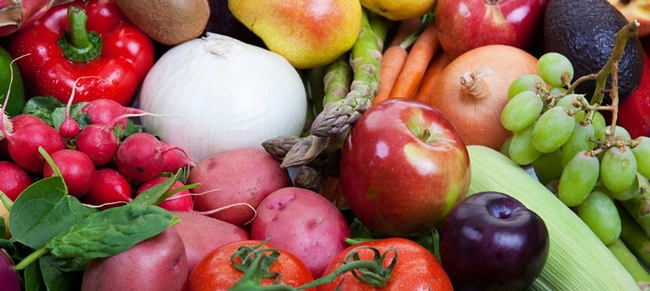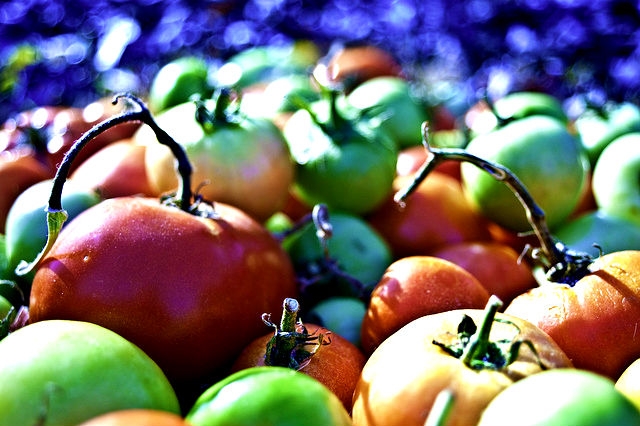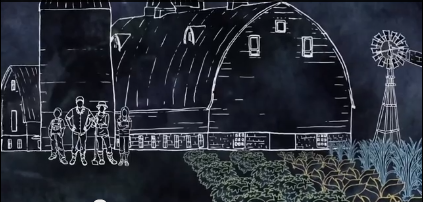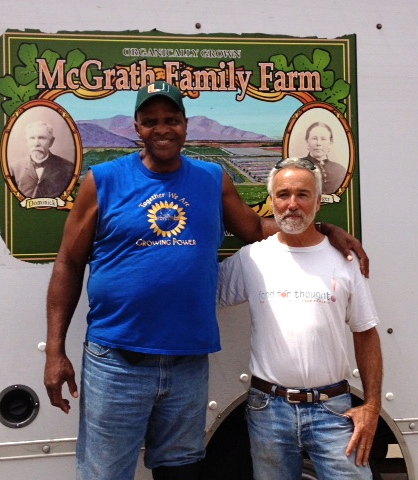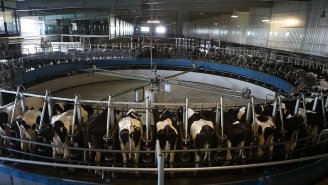Blog
To feed the world, light its chicken coops, UC Davis entrepreneurs suggest
Sometimes a tiny innovation can crack the world's toughest problems. Take, for example, a small solar-powered LED light placed in a chicken coop in a developing country.
The light stretches winter daylight hours, boosts the hens' egg production, puts a reliable supply of nutritious food on the farmer's table and moves a nation a step closer to food security.
That may leave you breathless, but it's the meticulously strategized dream of three young visionaries, all affiliated with UC Davis. The trio, calling themselves Henlight, will travel to Berlin Sept. 18 as one of five teams from across the globe competing for investment funding in the finals of the international 2013 Thought for Food Challenge Summit.
From left, UC Davis entrepreneurs Lorena Galvan, Emily Sin and Edward Silva hold a silkie chicken and their new product, a Henlight. (Gregory Urquiaga/UC Davis photo )
henlight lg
Dr. Margaret Mellon -- My views on GMOs are more nuanced
The following is a response from Dr. Margaret Mellon, a participant in the Boston Review Magazine Forum that was mentioned here.
As a participant in the Boston Review Magazine forum, I take issue with the sweeping statement that all of the participants agreed that the GE crops currently on the market are safe to eat and safe for the environment. My views on both topics are more nuanced.
I agree that GE products currently on the market--overwhelmingly herbicide tolerant (HT) and BT crops--are unlikely to be allergenic or toxic and on that basis are likely safe to consume. But I also believe that there are holes in the risk assessment process that leave some questions unanswered. This month’s issue of Nature Biotechnology has an excellent feature discussing the challenges of food safety testing.
Moreover, it is important to note that each GE product must be individually assessed for food safety and that the safety status of the HTC and BT crops says little about foods that might be introduced in the future. For example, serious attention needs to be paid to the possibility that GE products produced by gene silencing might inadvertently turn off non-target genes in people who consume them.
I disagree strongly with the statement that the BT and HT crops are safe for the environment. Yes, scientists have documented pesticide reductions in pesticide use immediately following the introduction of these crops, which I welcome and applaud. But these benefits exist only until resistance develops to glyphosate or the BT toxins.
Glyphosate-resistant weeds have already arisen across the US and are leading to enormous increases in pesticide use, reversing the early reductions attributable to the HT crops. The biotechnology industry’s response is a new generation of transgenic crops that enable the use of older, more herbicides like 2,4 D and dicamba. Unless U.S. agriculture responds swiftly, we will soon be facing a nightmare scenario of increased pesticide use resulting from resistant weeds. This is not an example of an environmentally beneficial technology.
BT has proven much more durable, in part because strong regulations allowed the government to impose refuge requirements on U.S. farmers. But resistance has already arisen in corn root worms in the Midwest and is leading to increased chemical insecticide use.
Dr. Margaret Mellon
Senior Scientist, Food & Environment Program
Union of Concerned Scientists
veggies
Scientific America: Buddhist Economics and A GMO rethink
Reposted from Scientific America -- Food Matters Blog
Discussions about plant genetic engineering often reflect two starkly opposing narratives. On the one side are the angry mobs who invade research farms to destroy fragile green rice seedlings deemed “GMOs”. On the other, are the scientists who call for calm and respect for publicly funded research. Too often, it seems, there is little mutual understanding.
In a forum on September 5 hosted by the Boston Review Magazine, a group of journalists, activists, plant biologists, and farmers as well as academic experts in food security, international agricultural and environmental policy sat around a virtual table to find common ground. All accepted the broad scientific consensus that the process of GE does not pose inherent risks compared to conventional approaches of genetic alteration and that the GE crops currently on the market are safe to eat and safe for the environment. That agreement allowed the discussion to move forward to a more societally relevant issue- the use of appropriate technology in agriculture....
...What criteria can scientists, farmers and consumers use to assess which type of these genetic technologies is most appropriate for agriculture?
In his 1973 book Small is Beautiful, economist E. F. Schumacher states that an appropriate technology should be low cost, low maintenance and promote values such as health, beauty, and permanence. Environmentalist Stewart Brand used a similar framework to select new technologies for inclusion in his 1969 Whole Earth Catalog. One of the purposes of the Whole Earth catalog was to facilitate a creative or self-sustainable lifestyle.
We can apply Brand and Schumacher’s Buddhist economic criteria to evaluate modern agricultural technologies....
...Golden Rice is an excellent example of how a particular genetic technology can appropriately serve a specific societal purpose – in this case, enhancing the health and well-being of farmers and their families. It is a relatively simple technology that scientists in most countries, including many developing countries, have perfected. The product, a seed, requires no extra maintenance or additional farming skills. The seed can be propagated on the farm each season at no extra cost through self-pollination and improved along the way.
Can we conclude from the example of Golden Rice that all GE seeds fall into the category of appropriate technology? Unfortunately it is not that simple. Each agricultural technology must be evaluated on a case-by-case basis. It is not informative to group all “GMOs” together without regard to the purpose of the engineering, the needs of the farmer, or the social, environmental, economic, or nutritional benefits.
images-4
Wildfires and Climate Change
Reposted from The New York Times
(Yosemite fire)
Increasing incursions by humans into forests, coupled with altered forest ecology and climate change, will make fires bigger and more destructive, with implications for air quality as well as homes and infrastructure.
“We face the increased risk of fires almost everywhere,” said Chris Field, director of the department of global ecology at the Carnegie Institution for Science, who is co-chairman of a working group for the Intergovernmental Panel on Climate Change.
Next March, the working group of which Dr. Field is co-chairman at the Intergovernmental Panel on Climate Change, the U.N. group, will publish a report that discusses wildfires as part of a broader look at the effects of climate change and the vulnerabilities of certain areas.
When large fires burn, they can have serious international consequences. In a sense, Dr. Field said, they are a “teachable moment,” showing the risks of climate change.
ALeqM5hh pcSPQe-PuoUlAQw2oUYB7tcVQ
Sacramento Region's AgStart Combines Technology & Agriculture
Reposted from California Economic Summit
Have you ever planted a seed, be it a plant, fruit or flower, and watched it grow? Patience is the key to seeing that seed sprout and reach its full potential.
In this case, the Sacramento Regional Technology Alliance (SARTA) has planted the seed with its newest industry-cluster focused program called AgStart, combining the strength of California's tech and agriculture sectors.
Thanks to an i6 Challenge grant from the US Economic Development Administration (EDA), SARTA and UC Davis are working together to support, identify, invigorate and accelerate agriculture technology companies and entrepreneurs.
"Currently there is a huge, and growing, need for agriculture technology to increase productivity and yield, improve cost effectiveness, and enhance the efficient use of resources such as water, energy, and land,” said Meg Arnold, SARTA CEO. “Ag technologies can, among other things, turn farm waste into energy, improve the drought tolerance of crops, increase food safety, provide for integrated pest management, drive the efficient use of water, and so much more.”
AgStart covers an area of 11 counties around Sacramento from Kern to San Joaquin and Stanislaus Counties.
The plan for the first year will be to:
• Develop and maintain the first map of the region's ag tech companies. -- They’re already over halfway to their goal of identifying 120 tech companies by the end of the year.
• Host a PitchFest, a competition to highlight successful ag tech companies -- Finals are Thursday, September 19
• Represent the region at the prestigious Ag Innovation Showcase in Missouri, the largest ag tech showcase in the world.
• Bring the ag innovation sector to SARTA's long-standing CleanStart Showcase in October.
"We are working with ag tech companies in their research and development,” said Dough Kohl, Program Director, AgStart. “We are making leadership series available, we are seeing where we can help introduce them to investors, as well as others in the ag tech industry who they might partner with and guiding them along the way to bring them to that next level.”
To read the rest of the story...
toma
Can sustainable agriculture feed the world?
We've all heard the argument that organic agriculture cannot feed the world. But as we've seen with the high number of both starving and obese individuals in the world, our current system isn't working either.
If organic agriculture isn't the answer, what about practices close to organic agriculture? What about sustainable agriculture? Can sustainable agriculture feed the world? According to Mark Bittman of the New York Times, it certainly can.
According to Bittman, "Anyone who opens his or her eyes sees a natural world so threatened by industrial agriculture that it’s tempting to drop off the grid and raise a few chickens." But sustainable agriculture practices, such as agro-ecology, immediately help support small farmers in less expensive and more productive ways, and make the system less susceptible to climate shocks.
Even the World Bank supports a shift to more sustainable agricultural practices. Their International Assessment of Agricultural Knowledge, Science and Technology for Development Report, calls on sustainable practices as a solution to poverty, food security, malnutrition and poor health, environmental degradation, and more.
Anna Lappe, author and food activist, also argues in favor of sustainable agriculture as a means to feeding our growing population. Her short video "Can Sustainable Agriculture Feed the World" markets itself as a myth-buster against large-scale industrial agriculture.
What do you think? Can we feed the world with sustainable agriculture alone?
2013-08-22 1457
Growing Power and McGrath Family Farms
Each of us has a favorite food, a favorite book, a favorite movie.
My favorite foods are blueberries, cheese, chocolate, and coffee. (I eat more blueberries than cheese or chocolate. Coffee…well that is its own food group). My favorite book is “The Catcher in the Rye”. My favorite movie is “Babe,” a wonderful tale about a pig who challenges orthodoxy and changes his fate by embracing an unlikely career.
I also have some favorite organizations. One of them is Growing Power, a Milwaukee-based, national nonprofit organization whose mission is to support people by helping to provide equal access to healthy, high-quality, safe and affordable food in all communities. Growing Power implements this mission by providing hands-on training, the demonstration of best practices, outreach/education, and technical assistance. Growing Power has been a defining presence in the (re)emergence of urban agriculture in the United States. The organization catalyzes projects all around the nation.
Growing Power was created in 1993 by Will Allen. Will Allen’s biography is, well, amazing. Raised on a family farm, Allen has had a varied career. A former professional basketball player and marketing professional, an author and speaker, Allen is also a farmer. For his work in urban agriculture, Allen has received recognition from the Ford Foundation, the MacArthur Foundation "Genius Grant” and the Kellogg Foundation. He is both prophetic and particular: he inspires, but he also provides important and specific information about the art and science of food production.
On a recent day, Allen visited Phil McGrath’s farm in Ventura County. He was visiting Southern California as part of a multi-state project in which UC ANR’s Rachel Surls is engaged. A small group of us joined Will for a tour of Phil’s farm. I’ve visited Phil’s farm before, but each time, I learn new things. I have a few takeaways from listening in on a conversation between two of my favorite farmers.
One is that farmers speak the same language. They share their best practices, their hopes, their aspirations. They are generous. They are civic minded. They want to learn, and to teach. They work in challenging and ever-evolving situations. For example, US 101 and an airport border Phil’s land. Some adjacent farmland has recently been sold for development. In the next few years, Phil will face more pressures on his farming operation, as what was once a rural setting becomes the peri-urban interface. Phil’s family – his ancestors immigrated from Ireland - has been farming locally for generations; the landscape as they experienced it has changed vastly.
Another takeaway is the vital role that farmers play in educating youth and the public about their work. In any educational work about agriculture, producers ought to be front and center. (And I wish they were in classrooms more often. Food systems ought to be part of our new national core curriculum). Phil’s innovative operation is full of young people, many of whom never envisioned agriculture as a career opportunity. Although he educates people of all ages, Will’s work in Growing Power initially started out as a program that offered teens an opportunity to work at his store and renovate greenhouses to grow food for their community. Growing Power provides one of the best models I’ve seen for youth education, and perhaps more importantly, for youth engagement and empowerment around the food system.
My third takeaway is this: I learn new things every time I visit a farm. It’s an opportunity I cherish, an opportunity to regenerate, to renew my appreciation about where my food comes from, and to engage with the most wonderful kinds of people.
I feel a special connection to both of these farmers. Both inspire me. Ventura County is my home. I value its producers, including Phil. And as a descendant of Dutch nationals who immigrated to Milwaukee (some later pushed west to farm in Iowa), Growing Power holds a special place in my heart. No matter where you’re from, food is fundamental. Cherish farmers.
Will Allen and Phil McGrath
Oceana Suggests -- Saving the Oceans Can Feed the World
"Oceans cover 71% of the planet and are the source of life on Earth. Over a billion people, including some of the poorest in the world, depend on the oceans and wild seafood for survival.
The good news is that our oceans are astoundingly resilient. Contrary to popular belief, the sea is not ungoverned.
We can turn things around if we focus on three goals: ending overfishing, controlling bycatch and protecting our ocean nurseries. Help us ensure that the oceans remain bountiful and beautiful for generations to come."
From Oceana.org
Do you agree or disagree? Is there more to it? Share your thoughts in the comments.
World's first lab-grown burger to be cooked and eaten
Reposted from BBC News
The world's first lab-grown burger is to be unveiled and eaten at a news conference in London on Monday.
Scientists took cells from a cow and, at an institute in the Netherlands, turned them into strips of muscle which they combined to make a patty.
Researchers say the technology could be a sustainable way of meeting what they say is a growing demand for meat.
Critics say that eating less meat would be an easier way to tackle predicted food shortages.
BBC News has been granted exclusive access to the laboratory where the meat was grown in a project costing £215,000.
Prof Mark Post of Maastricht University, the scientist behind the burger, said: "Later today we are going to present the world's first hamburger made in a lab from cells. We are doing that because livestock production is not good for the environment, it is not going to meet demand for the world and it is not good for animals".
But Prof Tara Garnett, head of the Food Policy Research Network at Oxford University, said decision-makers needed to look beyond technological solutions.
"We have a situation where 1.4 billion people in the world are overweight and obese, and at the same time one billion people worldwide go to bed hungry," she said.
"That's just weird and unacceptable. The solutions don't just lie with producing more food but changing the systems of supply and access and affordability so not just more food but better food gets to the people who need it."
Read the rest of the article>>
69085558 burg
California looks to milk China’s growing dairy demand - Center for Investigative Reporting
From the Center for Investigative Reporting:
A growing demand for milk and cheese in China has the potential to bring California’s beleaguered dairy industry back to life – and with it, renewed concern about its damaging effects on the environment.
As China’s middle class grows, so does its penchant for dairy products such as milk, cheese and yogurt. U.S. government data show that Chinese demand for dairy products is growing rapidly. For instance, between 2011 and 2012, imports of skimmed milk powder grew by 49 percent and are expected to increase an additional 18 percent this year.
And although China is trying to build its nascent dairy industry to meet this demand, it relies heavily on imports of high-protein feed. That includes one of California’s most water-intensive crops, alfalfa.
“Exports (of alfalfa) to China are definitely increasing,” said Daniel Putnam, an agronomist at the University of California, Davis and UCANR specialist. “We’ve seen a pretty dramatic rise since 2006, and I think all expectations are that it will probably increase again this year.”
Read the full article and watch the video online>>
dairy cow merry go round




